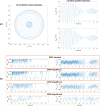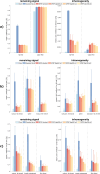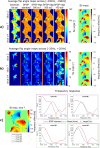Fast online spectral-spatial pulse design for subject-specific fat saturation in cervical spine and foot imaging at 1.5 T
- PMID: 38366129
- PMCID: PMC10995033
- DOI: 10.1007/s10334-024-01149-8
Fast online spectral-spatial pulse design for subject-specific fat saturation in cervical spine and foot imaging at 1.5 T
Abstract
Objective: To compensate subject-specific field inhomogeneities and enhance fat pre-saturation with a fast online individual spectral-spatial (SPSP) single-channel pulse design.
Methods: The RF shape is calculated online using subject-specific field maps and a predefined excitation k-space trajectory. Calculation acceleration options are explored to increase clinical viability. Four optimization configurations are compared to a standard Gaussian spectral selective pre-saturation pulse and to a Dixon acquisition using phantom and volunteer (N = 5) data at 1.5 T with a turbo spin echo (TSE) sequence. Measurements and simulations are conducted across various body parts and image orientations.
Results: Phantom measurements demonstrate up to a 3.5-fold reduction in residual fat signal compared to Gaussian fat saturation. In vivo evaluations show improvements up to sixfold for dorsal subcutaneous fat in sagittal cervical spine acquisitions. The versatility of the tailored trajectory is confirmed through sagittal foot/ankle, coronal, and transversal cervical spine experiments. Additional measurements indicate that excitation field (B1) information can be disregarded at 1.5 T. Acceleration methods reduce computation time to a few seconds.
Discussion: An individual pulse design that primarily compensates for main field (B0) inhomogeneities in fat pre-saturation is successfully implemented within an online "push-button" workflow. Both fat saturation homogeneity and the level of suppression are improved.
Keywords: 1.5 T MRI; Dynamic RF pulses; Dynamic transmission; Fat saturation; Pulse design.
© 2024. The Author(s).
Conflict of interest statement
CKE and AMN receive research support from Siemens Healthcare GmbH. PL, JH, DR and DG are employees of Siemens Healthcare GmbH. SL is an employee of Siemens Healthcare Pty Ltd.
Figures






Similar articles
-
Four dimensional spectral-spatial fat saturation pulse design.Magn Reson Med. 2014 Dec;72(6):1637-47. doi: 10.1002/mrm.25076. Epub 2013 Dec 17. Magn Reson Med. 2014. PMID: 24347327 Free PMC article.
-
A novel spectrally selective fat saturation pulse design with robustness to B0 and B1 inhomogeneities: A demonstration on 3D T1-weighted breast MRI at 3 T.Magn Reson Imaging. 2021 Jan;75:156-161. doi: 10.1016/j.mri.2020.10.015. Epub 2020 Oct 29. Magn Reson Imaging. 2021. PMID: 33130057 Free PMC article.
-
Tailored spiral in-out spectral-spatial water suppression pulses for magnetic resonance spectroscopic imaging.Magn Reson Med. 2018 Jan;79(1):31-40. doi: 10.1002/mrm.26683. Epub 2017 Mar 31. Magn Reson Med. 2018. PMID: 28370494 Free PMC article.
-
Clinical application of 3D VIBECAIPI-DIXON for non-enhanced imaging of the pancreas compared to a standard 2D fat-saturated FLASH.Clin Imaging. 2014 Mar-Apr;38(2):142-7. doi: 10.1016/j.clinimag.2013.11.005. Epub 2013 Nov 19. Clin Imaging. 2014. PMID: 24332974
-
Controlling Through-Slice Chemical-Shift Artifacts for Improved Non-Fat-Suppressed Musculoskeletal Turbo-Spin-Echo Magnetic Resonance Imaging at 7 T.Invest Radiol. 2021 Sep 1;56(9):545-552. doi: 10.1097/RLI.0000000000000778. Invest Radiol. 2021. PMID: 33813573
Cited by
-
Improving tissue contrast visualization in two-point Dixon MRI using dark-fat processing: application in clinical knee imaging.Skeletal Radiol. 2025 Aug;54(8):1739-1748. doi: 10.1007/s00256-025-04925-2. Epub 2025 Apr 12. Skeletal Radiol. 2025. PMID: 40220143
References
MeSH terms
LinkOut - more resources
Full Text Sources
Medical

